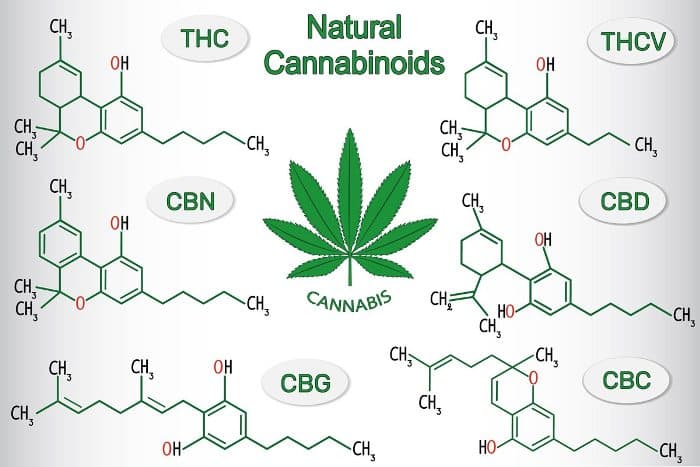
The “Entourage effect” of Cannabis.
Most animal studies with cannabidiol utilize synthetic, single-molecule CBD produced by biochemical laboratories for research purposes. In contrast, whole plant extractions typically include CBD, THC, and more than 400 trace compounds. Many of these compounds interact synergistically to create what scientists refer to as an “entourage effect” that magnifies the therapeutic benefits of the plant’s individual components—so that the medicinal impact of the whole plant is greater than the sum of its parts. It is important to consider the entourage effect (or lack thereof) when extrapolating data based on animal studies: 100 milligrams of synthetic single-molecule CBD is not equivalent to 100 milligrams of a CBD-rich whole plant cannabis extract. “Cannabis is inherently polypharmaceutical,” Dr. John McPartland notes, “and synergy arises from interactions between its multiple components.” The clinical contribution of cannabinoids different than THC, terpenoids and flavonoids to clinical cannabis effects has been espoused as an “entourage effect” (Mechoulam and Ben-Shabat 1999). While THC remains the most psychoactive compound found in Cannabis, all other substances present in the plant (in particular cannabinoids, terpenoids and flavonoids) also have unique properties that will ultimately influence the effects that Cannabis has on us.
Many times patients using Cannabis as medicine have reported that a specific plant genetic seems to have better therapeutic properties on them than other ones available. When compared, those Cannabis varieties had similar cannabinoid profile (content of cannabinoids such as THC and CBD). So if the difference is not in the cannabinoid content, it must lie in the “entourage” of other substances present in the plant in order to explain the difference perceived by various patients.
- Taming THC: Potential Cannabis Synergy and Phytocannabinoid-Terpenoid Entourage Effects Ethan Russo MD British Journal of Pharmacology http://cannabisclinicians.org/wp-content/uploads/2013/10/Russo-Entourage-Effect-2011.pdf
- Marijuana and the Cannabinoids Mahmoud A. ElSohly School of Pharmacy at the University of Mississippi http://www.alchimiaweb.com/blogfr/wp-content/uploads/2012/09/Mahmoud-A.-ElSohly-Marijuana-and-the-Cannabinoids-Forensic-Science-and-Medicine.zip
- Terpenoids for medicine Justin Fischedick Leiden University https://openaccess.leidenuniv.nl/bitstream/handle/1887/20608/04.pdf?sequence=23
- The inheritance of chemical phenotype in Cannabis sativa L. (IV): cannabinoid-free plants E. P. M. de Meijer, K. M. Hammond, A. Sutton http://www.csatc.org/linksofinterest/deMeijer20092.pdf
It has been found that, THC is the ingredient in Cannabis responsible for its pain relieving effects.
Studies show that THC activates the pathways in the central nervous system, which work to block pain signals from being sent to the brain. Cannabis has been shown to be especially effective against neuropathic pain, or nerve-related pain. Post-traumatic stress disorder (PTSD) is another condition, shown effective with medical cannabis. The high from THC is also associated with temporary impairments of memory. While this may be seen as a drawback for some cannabis users, impaired memory is often therapeutic for those who struggle to , such as patients who suffer from PTSD. Recent studies confirm that oral doses of THC can help relieve a variety of PTSD-related symptoms including flashbacks, agitation and nightmares.
Properties of Cannabinoids
- Δ8-THC (∆8-Tetrahydrocannabinol) Analgesic
- Δ9-THC (∆9-Tetrahydrocannabinol) Analgesic, Antidepressant, Antiemetic, Antiepileptic, Anti-proliferative, Antipsychotic, Antinausea, Antineoplastic, Antispasmodic, Anxiolytic, Appetite stimulant, Anti Glaucoma, Helps with Neuropathic pain.
- Δ9-THCA (∆9-Tetrahydrocannabinolic Acid) Anti-proliferative, Antispasmodic
- Δ9-THCV (∆9-Tetrahydrocannabivarin) Anorectic, Antiepileptic, Bone stimulant
- CBC (Cannabichromene) Analgesic, Anti-inflammatory, Antimicrobial, Antiproliferative, Bone stimulant
- CBCA (Cannabichromic Acid) Antifungal, Anti-inflammatory
- CBD (Cannabidiol) Analgesic, Antidiabetic, Antiemetic, Antiepileptic, Anti-inflammatory, Anti-ischemic, Antimicrobial, Antineoplastic, Anti-proliferative, Antipsoriatic, Antipsychotic, Antispasmodic, Anxiolytic, Bone stimulant, Immonosuppressive, Intestinal anti-prokinetic, Neuroprotective, Vasodilative
- CBDA (Cannabidiolic Acid) Anti-inflammatory, Anti-proliferative
- CBDV (Cannabidivarin) Anticonvulsant, Bone stimulant
- CBG (Cannabigerol) Antimicrobial, Anti-proliferative, Bone stimulant
- CBGA (Cannabigerolic Acid) Analgesic, Anti-inflammatory, Antimicrobial
- CBN (Cannabinol) Analgesic, Anti-inflammatory, Antioxidant, Sedative
- CBL (Cannabicyclol) Anti-inflammatory, Antimicrobial
- AEA (Anandamide) is an often missed endocannabinoid found in the human body. Anandamide is the brain’s own THC (just like “endorphin” is the brain’s own morphine). Anandamide has only been found in two plants – Cacao (chocolate) and Cannabis. The name Anandamide is taken from the Sanskrit word (and Hinduistic religious term) ananda, which means “joy, bliss, delight”, and amide. Anandamide regulates the functions of our central nervous system and our immune system. AEA regulates appetite, memory, sensations of pleasure and pain, our immune system, and sleep patterns. It also inhibits certain cancers, such as breast cancer in humans. It is used in the drug therapy of hypertension and cerebrovascular spasms, as myocardial protective agents, and in the relaxation of uterine spasms. Research suggests that anandamide plays a role in the making and breaking of short-term connections between nerve cells, and this is related to learning and memory. Animal studies suggest that too much anandamide induces forgetfulness. This suggests that if substances could be developed that keep anandamide from binding to its receptor, these substances might be used to treat memory loss or even to enhance existing memory.
- THC and the other cannabinoids have no odor.
